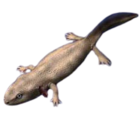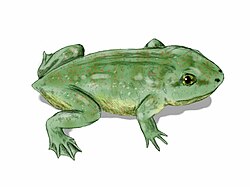Marmorerpeton
| Marmorerpeton Temporal range: Middle Jurassic,
| |
|---|---|
| Scientific classification | |
| Domain: | Eukaryota |
| Kingdom: | Animalia |
| Phylum: | Chordata |
| Class: | Amphibia |
| Family: | †Karauridae |
| Genus: | †Marmorerpeton Evans et al. 1988 |
| Type species | |
| †Marmorerpeton freemani Evans et al. 1988
| |
| Species | |
| |
Marmorerpeton is an extinct genus of prehistoric stem group-salamanders from the Middle Jurassic of the United Kingdom.[1] They are among the oldest known salamanders.[2]
The genus was first described by Susan E. Evans et al. in 1988, when two species were named: M. freemani, and M. kermacki.[1] The material mainly comprised disarticulated vertebrae, partial jaws, and partial skull roofing bones with heavy sculpture. It was recovered via screenwashing from the locality of Kirtlington. Previously the unit was considered to be part of the Forest Marble Formation[1] but it is now considered part of the White Limestone Formation.[3]
Marmorerpeton is a relatively large stem-salamander, and is estimated to have reached at least 40 centimetres (16 in),[1] and possibly 55–60 centimetres (22–24 in).[4] The size of their osteocytic lacunae indicate a large genome size and some morphological characters, such as the presence of calcified cartilage in the medulla of its humerus, suggested that Marmorerpeton was neotenic.[5][6]


Further remains of Marmorerpeton representing a new species, M. wakei, were described in 2022 from the Kilmaluag Formation of the Isle of Skye, Scotland. These remains are partly articulated and include a nearly complete skull, complete tail, partly articulated back bone, and several limb bones. These remains conclusively demonstrated that Marmorerpeton was neotenic, and was a member of the family Karauridae, with the other two members of the family, Karaurus and Kokartus which are known from the Middle-Late Jurassic of Central Asia.[7] The teeth appear to have been weakly pedicellate.[1]
References
[edit]- ^ a b c d e Evans, S. E.; Milner, A. R.; Mussett, F. (1988). "The earliest known salamanders (Amphibia, Caudata): a record from the Middle Jurassic of England". Geobios. 21 (5): 539–552. Bibcode:1988Geobi..21..539E. doi:10.1016/s0016-6995(88)80069-x.
- ^ Marjanovic, D.; Laurin, M. (2014). "An updated paleontological timetree of lissamphibians, with comments on the anatomy of Jurassic crown-group salamanders (Urodela)". Historical Biology. 26 (4): 535–550. Bibcode:2014HBio...26..535M. doi:10.1080/08912963.2013.797972. S2CID 84581331.
- ^ Wills, Simon; Bernard, Emma Louise; Brewer, Philippa; Underwood, Charlie J.; Ward, David J. (1 April 2019). "Palaeontology, stratigraphy and sedimentology of Woodeaton Quarry (Oxfordshire) and a new microvertebrate site from the White Limestone Formation (Bathonian, Jurassic)". Proceedings of the Geologists' Association. 130 (2): 170–186. doi:10.1016/j.pgeola.2019.02.003. ISSN 0016-7878. S2CID 135409990.
- ^ Skutschas, Pavel; Kolchanov, Veniamin; Krasnolutskii, Sergey; Averianov, Alexander; Schellhorn, Rico; Schultz, Julia; Martin, Thomas (19 February 2020). "A new small-sized stem salamander from the Middle Jurassic of Western Siberia, Russia". PLOS ONE. 15 (2): e0228610. Bibcode:2020PLoSO..1528610S. doi:10.1371/journal.pone.0228610. ISSN 1932-6203. PMC 7029856. PMID 32074114.
- ^ Laurin, M.; Canoville, A.; Struble, M.; Organ, C.; de Buffrénil, V. (2015). "Early genome size increase in urodeles". Comptes Rendus Palevol. 15 (1–2): 74–82. doi:10.1016/j.crpv.2014.12.006.
- ^ de Buffrénil, V.; Canoville, A.; Evans, S. E.; Laurin, M. (2015). "Histological study of karaurids, the oldest known (stem) urodeles". Historical Biology. 27 (1): 109–114. Bibcode:2015HBio...27..109D. doi:10.1080/08912963.2013.869800. S2CID 83557507.
- ^ Jones, Marc E. H.; Benson, Roger B. J.; Skutschas, Pavel; Hill, Lucy; Panciroli, Elsa; Schmitt, Armin D.; Walsh, Stig A.; Evans, Susan E. (11 July 2022). "Middle Jurassic fossils document an early stage in salamander evolution". Proceedings of the National Academy of Sciences. 119 (30). Bibcode:2022PNAS..11914100J. doi:10.1073/pnas.2114100119. ISSN 0027-8424. PMID 35858401.





